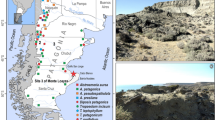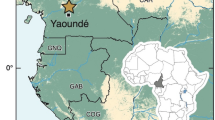Abstract
Charred residues adhering to sherds of ceramic cooking vessels, pots (Fu), excavated from the Kuahuqiao site (8000–7000 cal a BP) in Zhejiang Province were examined using the method of starch grain analysis. Ancient starch grains were recovered from charred residues and were classified into 8 genera. Remains from rice (Oryza spp.), job’s-tears (Coix chinesis T.), bean (Vigna spp.), acorn (Quercus spp.) as well as possibly buckeye tree (Aesculus chinensis B.) were identified. Other starch grains from unidentified plants were also recovered. Tracheids with bordered pits from softwood fibers were also found, indicating that some food might have been processed with wooden tools. The range of starch grains in the charred residues adhering to the ceramic pots reveals the diversity of ancient plant foods at the Kuahuqiao site, Zhejiang Province.
Similar content being viewed by others
References
Yang Y M. Residues analysis and their employment in archaeology (in Chinese). Relics From South, 2008, 20–26
Torrence R, Barton H. Ancient Starch Research. Walnut Creek: Left Coast Press, 2006. 1–256
Perry L. Starch analysis reveal multiple functions of quarts “manioc” grater flakes from the Orinoco Basin, Venezuela. Interciencia, 2002, 27: 635–639
Perry L, Dickau R, Zarrillo S, et al. Starch fossils and the domestication and dispersal of chili peppers (Capsic µm spp. L.) in the Americas. Science, 2007, 315: 986–988
Piperno D R, Husum-Clary K, Cooke R G, et al. Preceramic maize from central Panama: Evidence from phytoliths and pollen. Am Anthropol, 1985, 87: 871–878
Piperno D R, Holst I. The presence of starch grains on prehistoric stone tools from the humid Neotripics: Indications of early tuber use and agriculture in Panama. J Archaeol Sci, 1998, 25: 765–776
Piperno D R, Ranere A J, Holst I, et al. Starch grains reveal early root crop horticulture in the Panamanian tropical forest. Nature, 2000, 407: 894–897
Piperno D R, Weiss E, Holst I, et al. Processing of wild cereal grains in the Upper Palaeolithic revealed by starch grain analysis. Nature, 2004, 430: 670–673
Zarrillo S, Pearsall D M, Raymond J C, et al. Directly dated starch residues document early formative maize (Zea mays L.) in tropical Ecuador. Proc Nat Acad Sci, USA, 2008, 105: 5006–5011
Lu H Y, Yang X Y, Ye M L, et al. Millet noodles in Late Neolithic China. Nature, 2005, 437: 967–968
Tao D W, Yang Y M, Huang W D, et al. Ancient starch grains from artifacts at Diaolongbei site. Chin Archaeol, 2009, 92–96
Yang X Y, Lü H Y, Liu T S, et al. Micromorphology characteristics of starch grains Setaria italica, Panicum miliaceum and S. viridis and its signification for archaeobotany (in Chinese). Quat Sci, 2005, 25: 224–227
Yang X Y, Kong Z C, Liu C J, et al. Characteristics of starch grains from main nuts in North China (in Chinese). Quat Sci, 2005, 25: 224–227
Yang X Y, Yi J C, Lü H Y, et al. Starch grain analysis reveals function of grinding stone tools at Shangzhai site, Beijing. Sci China Ser D-Earth Sci, 2009, 52:1164–1178
Zhejiang Provincial Institute of Cultural Relics and Archaeology, Xiaoshan Museum. Kuahuqiao Site (in Chinese). Beijing: Cultural Relics Press, 2004. 53–277
Horrocks M, Bedford S. Microfossil analysis of Lapita deposits in Vanuatu reveals introduced Araceae (aroids). Arch Ocean, 2004, 39: 67–74
Crowther A. Starch residues on undecorated Lapita pottery from Anir, New Ireland. Arch Oceania, 2005, 40: 62–66
Boyd M, Surette C, Nicholson B A. Archaeobotanical evidence of maize (Zea mays) consumption at the northern edge of the Great Plains. J Archaeol Sci, 2006, 33: 1129–1140
Henry A G, Hudson H F, Piperno D R. Changes in starch grain morphologies from cooking. J Archaeol Sci, 2009, 36: 915–922
Watanabe M. Knowledge of the Jomon Period (in Japanese). Tokyo: Tokyo Art Press, 1983. 79–85
Liu C J, Jin G Y, Kong Z C. Archaeobotany: Research on Seeds and Fruits (in Chinese). Beijng: Science Press, 2008. 160–201
Lee G, Crawford G W, Liu L, et al. Plants and people from the early Neolithic to Shang period in North China. Proc Nat Acaed Sci, USA, 2007, 104: 1087–1092
Dong Y C, Liu X. Crops and Their Wild Relatives in China, vol. Economic Crops (in Chinese). Beijing: Chinese Agriculture Press. 2007. 406–425
Hunan Provincial Museum, Institute of Archaeology of CAS. Tomb 1 of the Han Dynasty at Mawangdui, Changsha (in Chinese). Beijing: Cultural Relics Press, 1973
Author information
Authors and Affiliations
Corresponding author
About this article
Cite this article
Yang, X., Jiang, L. Starch grain analysis reveals ancient diet at Kuahuqiao site, Zhejiang Province. Chin. Sci. Bull. 55, 1150–1156 (2010). https://doi.org/10.1007/s11434-009-0545-0
Received:
Accepted:
Published:
Issue Date:
DOI: https://doi.org/10.1007/s11434-009-0545-0




